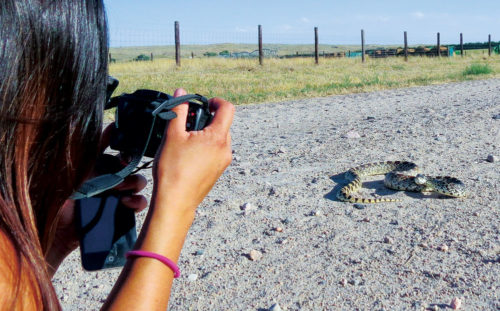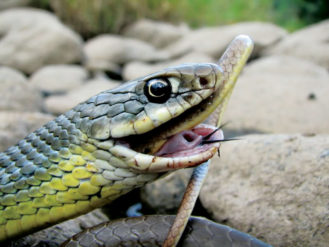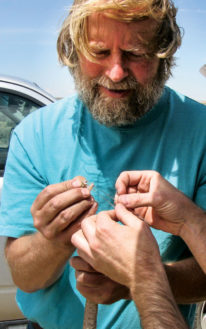
I remember the first time I stepped over a snake. Mid-stride, the round rock below me moved. It wasn’t a rock, but a coiled-up rattler. Yikes!
Colorado is full of snakes, as well as snake myths. Snakes have lived here since the Jurassic, and today about 30 snake species call Colorado home. They base-camp from serpentine lairs of the southeastern plains and occur all the way up to 11,000-ft.-high Rocky Mountain valleys. Our snakes are diverse too. They include constrictors like the kingsnakes, pit vipers like rattlesnakes, water-loving snakes like garter snakes, and underground ones like threadsnakes.

Photographing a bullsnake on a back country road in CO.
Snakes are a key part of our landscape because they’re food for many other creatures like foxes, eagles and raccoons. They’re also predators on smaller animals, from insects to lizards and even fish, worms or other snakes. Some snake prey can be pests, like plague-bearing prairie dogs, hantavirus-bearing mice, crop-eating grasshoppers, and rodents that carry disease-bearing ticks.
Human activities aren’t generally helpful for snake survival. Development diminishes their abundance, because these cold-blooded animals like to warm up in these sunny, open spaces like roads and trails, where they are prone to be run over. Cats and, to a lesser extent, dogs are common snake killers. But some places like Chatfield Reservoir or gently sloped irrigation ditches can provide regular habitat for snakes like the northern water snake.
Snakes also have economic value. For example, some snake venoms, after modification, have anticancerous or therapeutic qualities akin to those of a Gila monster’s venom. The latter’s a new Type II diabetes aid—because it suppresses appetite and regulates blood sugar. Plus, there’s the pet trade, where snakes and other venomous reptiles are part of a billion-dollar U.S. “herpetoculture” economy.
This time of year, snake sightings often increase as snakes return to their overwintering dens, or “hibernacula.” Sometimes they migrate en masse. Because its warmer during the day, that’s when they primarily travel—thus increasing our propensity to spot them more frequently in the early fall. Ditto for the spring when they emerge.

Cannibalism! Adult yellow-bellied racer swallowing a younger version of the same species in Douglas County, CO.
Colorado’s snakes are generally quite shy, especially toward larger animals like humans. Witness their great defensive or avoidance strategies. They camouflage, they play possum when threatened, and some even shake their tails, as if feigning that they’re rattlers. They have complex sensory systems that can include infrared (heat-reading) vision, vibration-sensitive “hearing,” and incredible chemical scent detection that they use to “smell”—that’s why they often flick their tongues out.
Like bears, snakes snuggle together in winter dens, and males exhibit mating displays and fights akin to bighorn sheep. They feed in interesting ways—killing their prey by constricting them, wolfing them down whole, or poisoning them.
Fortunately, the three dangerous types of venomous snakes here are easily recognized. All of them have stubby or rattle-bearing tails, as opposed to the pencil-tip tails of their nonpoisonous brethren.
And those pet boa constrictors that get dumped by owners? They can’t survive winters here, even on the plains. So Colorado snakes aren’t much of a risk to humans, pets or livestock.
The experts’ advice: If you encounter a snake, leave it alone. If it’s a rattler, move away slowly. None of our snakes are aggressive unless they’re threatened. Most attempts to play with, rescue, or kill the snake end up with a hand being bitten. Or worse, being covered in the stinky musk a garter snake releases when it’s trying to slither out of your grip.

Sampling venom from a rattlesnake in western Colorado.
Photo by Steve Mackessy.
What if you do get bitten? Don’t use a snake bite kit—they have been shown to be ineffective. Don’t try to kill or catch the snake—most folks that do this just get bitten again, and having the snake won’t help your doc heal you. What should you do? Get to the nearest hospital and ask for antivenom. Today’s antivenom, brewed from the antibodies of sheep, is quite effective compared to the stuff of old. The shorter the time between the bite and the antivenom, the better.
And that urban legend about baby snakes being deadlier? Not true. Whereas their venom might be twice as potent as an adult’s, they inject a twentieth to a hundredth as much when they bite. And, they do control their venom release—they can release a small amount or even none at all, producing a dry bite.
Colorado snakes reduce pests (if only they ate mosquitos!), they’re a key part of our ecosystem, and are harmless unless provoked. No need to scream or run away next time you see one. It’s probably thinking “Don’t tread on me.”
James Hagadorn, Ph.D., is a scientist at the Denver Museum of Nature & Science. Suggestions and comments are welcome at jwhagadorn@dmns.org.


0 Comments